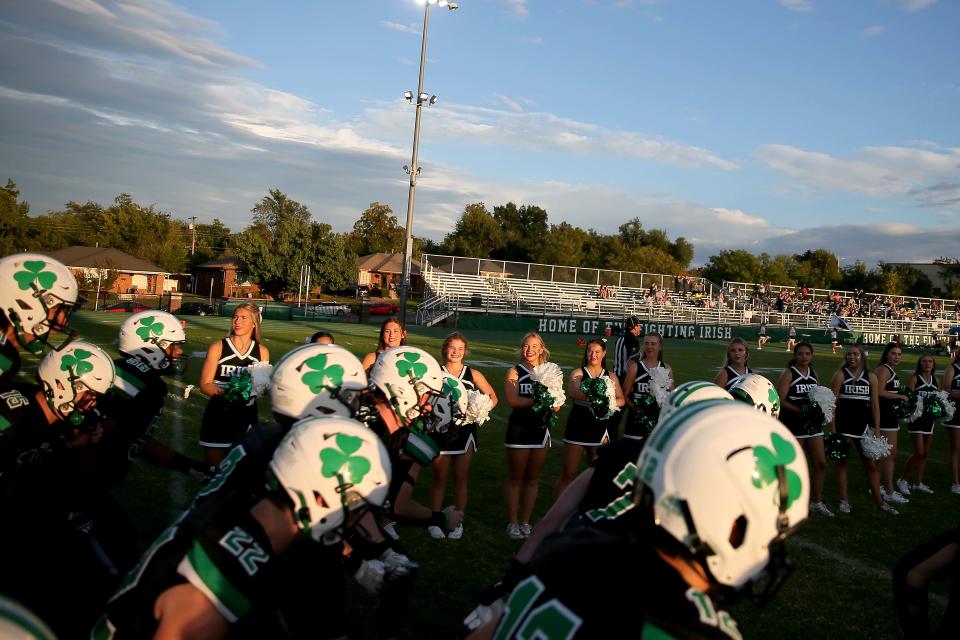OSSAA responds to private-school lawsuit over classification rule, saying it's not unfair

The Oklahoma Secondary School Activities Association has responded to a lawsuit filed last month by five of its private-school members, denying the schools’ claims that playing much larger public-school teams is unfair and saying the private schools first should have brought their concerns to the OSSAA Board of Directors.
Attorneys for the OSSAA filed the response this week in Oklahoma County District Court. There is no hearing set yet in the case, which will be heard by District Judge Richard Ogden.
“Prior to commencing this lawsuit,” the response noted, “plaintiffs have failed to ask for any exception to the application of OSSAA Rule 14 from the OSSAA’s governing Board of Directors and have failed to propose any amendment” of the rule for a vote by member schools since 2011, when the rule was implemented.
In their lawsuit, Bishop McGuinness, Mount St. Mary, Heritage Hall, Crossings Christian and Oklahoma Christian School in Edmond claimed the OSSAA’s Rule 14 – which the organization has said aims to create competitive balance between public and private schools in athletics — is unconstitutional and should be voided.
Under Rule 14, private schools must move up in classification — no matter their enrollment — if they meet certain success criteria in a sport. In some sports in which both boys and girls teams compete, both of a private school’s teams must move up, even if only one of them meets the success criteria.
More: Heritage Hall's Andy Bass, future Sooner, named Gatorade Oklahoma Football Player of Year
The schools claim the OSSAA, by denying them “proper division classification” based on what the OSSAA refers to as Average Daily Membership, or ADM, constitutes “an arbitrary and capricious decision in violation of the Oklahoma Administrative Procedures Act, in that such decision is founded solely on OSSAA’s historical animus toward private schools rather than any justifiable rationale.” The OSSAA denied those accusations and said the plaintiffs haven’t “received any prejudicial treatment.”
In its response, the OSSAA also said it “denies any implication that any certain number of classifications is the only fair or safe number for classifications for any particular activity and denies that the placement of any certain number or proportion of member schools within a classification is the only fair or safe number or proportion for that classification.”
The OSSAA noted Rule 14 was amended as recently as last June. The organization also noted two of the plaintiffs, OCS and Crossings Christian, serve on the OSSAA’s Rule 14 committee. Only one private-school representative, Lance Parks of Bishop Kelley High School in Tulsa, currently serves on the OSSAA Board of Directors.
Private schools began joining the OSSAA with the 1967-68 academic year. Rule 14 was developed after years of complaints from public schools about the postseason success of private schools. Originally, private-school football teams would be kept from rising above Class 5A, but now the cap is Class 6A Division II — the second-highest level of competition in that sport.
More: Where are Oklahoma high school athletes going to college? Here's the 2024 signing list
The OSSAA, in its response, denied the plaintiffs’ claim that “they are being required to compete against schools whose enrollment is orders of magnitude greater.”
In volleyball, Mount St. Mary, with an ADM of 362.17 students for the 2023-24 school year, this past fall competed in Class 6A — the highest class in that sport — against teams from the state’s largest high schools including Broken Arrow (5,537.46 ADM), Tulsa Union (4,550.63 ADM), Mustang (3,668.68 ADM), Jenks (3,500.54 ADM) and Owasso (2,956.50 ADM). To explain that apparently discrepancy, the OSSAA said Mount St. Mary “has willingly competed in regular season competitions against schools in higher classifications over the years” and noted the Rockets were “undefeated in district plan and won at least 90% of its total games.” Mount St. Mary posted a 37-4 record and lost in the 6A quarterfinals.
The OSSAA “denies any implication that ADM is the only fair or safe means for classifying school teams for post-regular season competition.”
The OSSAA also said Bishop McGuinness lost a lawsuit in 2014 against the OSSAA regarding Rule 14 and the school challenged the rule in that lawsuit “on the same basic that it is challenging Rule 14 in this matter.”
Earlier this year, the OSSAA board discussed tweaking Rule 14 or forming a new postseason bracket solely for private schools, a subject that’s been discussed for years. David Jackson, the OSSAA’s executive director, said in an OSSAA board meeting last February about 75% of OSSAA members had responded to a survey sent about the subject and about 85% of those voters favored the separate-bracket option.That brought a cease-and-desist letter from Oklahoma Attorney General Gentner Drummond, who said the proposal violated the U.S. Constitution’s 14th amendment and “bears no relation to a legitimate government purpose.”
This article originally appeared on Oklahoman: Private-school classification rule is not unfair, OSSAA says

